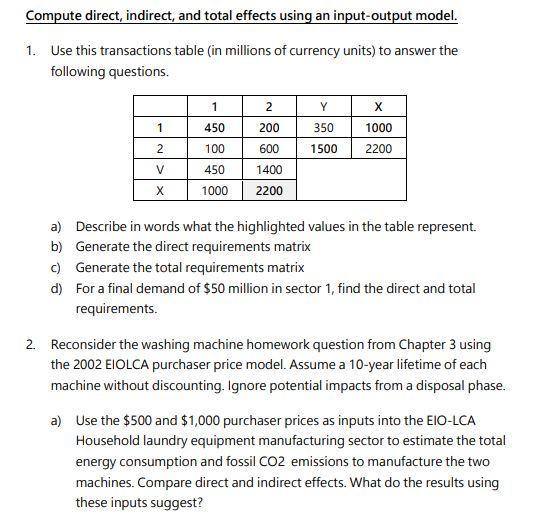Answered step by step
Verified Expert Solution
Question
1 Approved Answer
Compute direct, indirect, and total effects using an input-output model. 1. Use this transactions table (in millions of currency units) to answer the following


Compute direct, indirect, and total effects using an input-output model. 1. Use this transactions table (in millions of currency units) to answer the following questions. 1 2 V X 1 450 100 450 1000 2 200 600 1400 2200 Y 350 1500 X 1000 2200 a) Describe in words what the highlighted values in the table represent. b) Generate the direct requirements matrix c) Generate the total requirements matrix d) For a final demand of $50 million in sector 1, find the direct and total requirements. 2. Reconsider the washing machine homework question from Chapter 3 using the 2002 EIOLCA purchaser price model. Assume a 10-year lifetime of each machine without discounting. Ignore potential impacts from a disposal phase. a) Use the $500 and $1,000 purchaser prices as inputs into the EIO-LCA Household laundry equipment manufacturing sector to estimate the total energy consumption and fossil CO2 emissions to manufacture the two machines. Compare direct and indirect effects. What do the results using these inputs suggest? b) Use the assumptions about water use to estimate the use-phase energy and fossil CO2 emissions via input to the Water, sewage, and other systems sector. c) Use the assumptions about electricity use to estimate the use-phase energy and fossil CO 2 emissions via input to the Power generation and supply sector. d) Create a table summarizing the results above and find total energy and fossil CO2 emissions for the two machines. Determine the percent of energy and fossil CO2 emissions associated with manufacturing and use phases. What are some caveats you might want to note if presenting these results given your use of an IO-LCA model? Assess how an input-output model might be used as a screening tool. 3. You want to do a screening assessment of the energy needed to manufacture two different types of plain white cotton t-shirts, one from a discount store costing $5 and another from a specialty clothing store costing $15. What would the results of using an IO-LCA model's apparel sector suggest about the differences in their energy use for manufacture? What other differences are likely in their manufacturing energy use?
Step by Step Solution
★★★★★
3.45 Rating (161 Votes )
There are 3 Steps involved in it
Step: 1

Get Instant Access to Expert-Tailored Solutions
See step-by-step solutions with expert insights and AI powered tools for academic success
Step: 2

Step: 3

Ace Your Homework with AI
Get the answers you need in no time with our AI-driven, step-by-step assistance
Get Started


